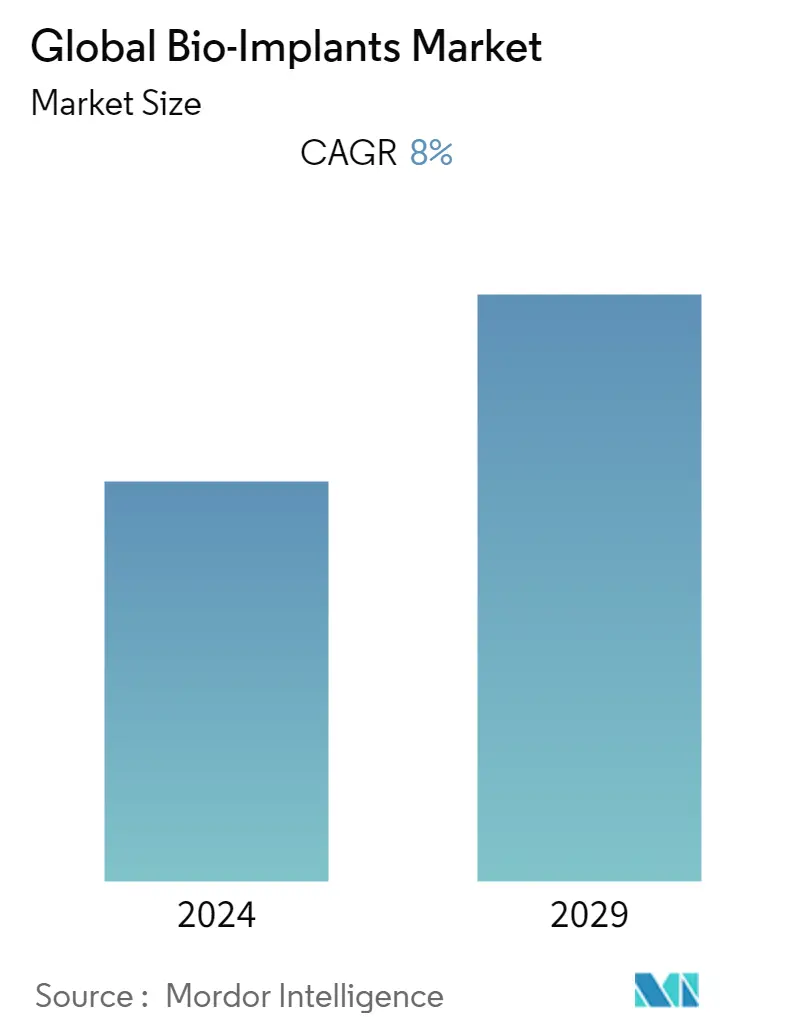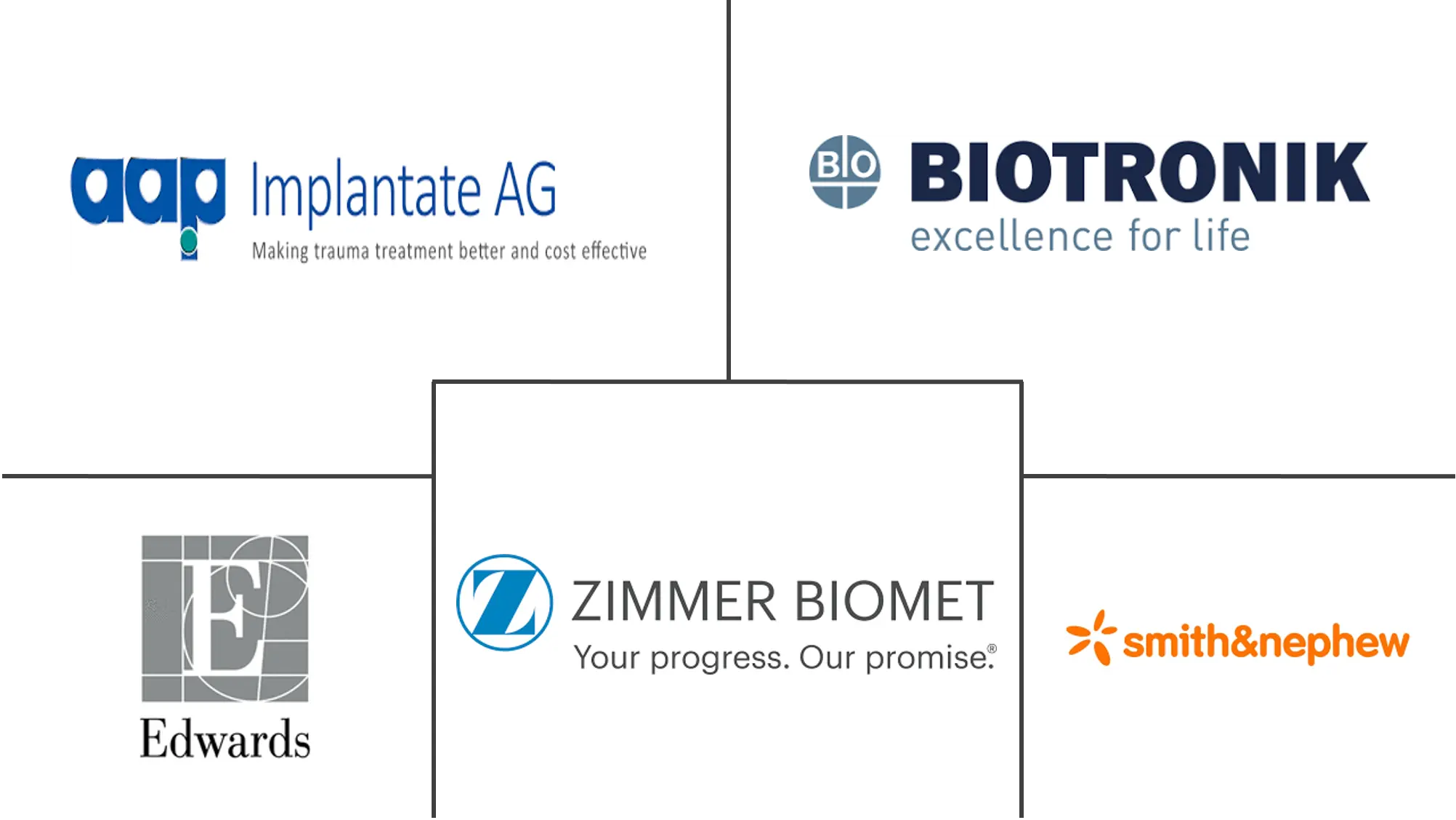Market Size of Global Bio-Implants Industry

| Study Period | 2021 - 2029 |
| Base Year For Estimation | 2023 |
| Forecast Data Period | 2024 - 2029 |
| CAGR | 8.00 % |
| Fastest Growing Market | Asia Pacific |
| Largest Market | North America |
| Market Concentration | High |
Major Players
*Disclaimer: Major Players sorted in no particular order |
Bio-Implants Market Analysis
The Bio-implants market is expected to register a CAGR of 8% over the forecast period.
The Covid-19 pandemic had an effect on the country's healthcare systems with significant impacts not only on the patients infected with COVID-19 but on others as well, which resulted in the cancellation of implant surgeries to manage and reserve the resources and many hospitals were facing a shortage of professionals to assist these surgeries. For instance, according to the study published in October 2021, by the National Library of Medicine globally, there has been a 42.8% decrease in general surgery admissions. Thus, the reduction in surgical procedures during the COVID-19 pandemic affected the market's growth. However, the postponed surgeries resumed worldwide, driving the market's growth during the post-pandemic period. Hence, the high number of surgical procedures and operations being performed is expected to boost the development of the bio-implant market during the forecast period.
The bio-implants market is primarily driven by the increasing burden of chronic diseases and lifestyle disorders and the rising preference toward minimally invasive surgeries. Bio-implants help in better management and specific drug delivery in conditions such as obesity, infections, and musculoskeletal disorders. For instance, bio-implants provide a unique and specific drug delivery for the skeletal system. According to an article published by Orthopaedic Surgery in January 2021, the total prevalence of lumbar spondylolisthesis in the middle-aged people of the Beijing community was 17.26% (15.98% in males and 18.80% in females). Women are more likely to suffer from lumbar spondylolisthesis after 60 years old. Furthermore, the 'UK Factsheet January 2022' published in 2022 by British Heart Foundation shows that around 7.6 million people live with heart and circulatory diseases, and nearly 4 million males and 3.6 million females live with heart and circulatory diseases in the country in 2021. This highly prevalent heart and circulatory disease among patients generate demand for more implant procedures and hospital admissions.
Additionally, the increasing product launches are expected to drive the growth of the market during the forecast period. In February 2021, Medtronic launched TYRX absorbable Antibacterial Envelope- an absorbable, single-use antibacterial envelope designed to stabilize a cardiac implantable electronic device or implanted neurostimulator.
Hence, the market studied is expected to witness steady growth over the forecast period. However, the high cost of bio-implants and unfavorable reimbursement policies are expected to restrain the growth of the market.
Bio-Implants Industry Segmentation
As per the scope of the report, a bio-implant is a prosthesis that is used to normalize physiological functions. It is made of biosynthetic materials, like collagen, and tissue-engineered products, like artificial skin and tissues. Some of the bioimplants are made up of polymers or biopolymers as well. The Bio-implants Market is segmented by Type of Bio-implants (Cardiovascular Implants, Spinal Implants, Orthopedic Implants, Dental Implants, Ophthalmic Implants, and Other Implants), Material (Biomaterial Metal and Alloys, Polymers, and Other Materials), and Geography (North America, Europe, Asia-Pacific, Middle East and Africa, and South America). The market report also covers the estimated market sizes and trends for 17 different countries across major regions globally. The report offers the value (in USD million) for the above segments.
| By Type of Bio-implants | |
| Cardiovascular Implants | |
| Spinal implants | |
| Orthopedic Implants | |
| Dental Implants | |
| Ophthalmic Implants | |
| Other Implants |
| By Material | |
| Biomaterial Metal and Alloys | |
| Polymers | |
| Other Materials |
| Geography | ||||||||
| ||||||||
| ||||||||
| ||||||||
| ||||||||
|
Global Bio-Implants Market Size Summary
The bio-implants market is poised for significant growth, driven by the increasing prevalence of chronic diseases and a rising preference for minimally invasive surgeries. The market experienced a temporary setback during the COVID-19 pandemic due to the postponement of surgical procedures, but has since rebounded as surgeries resumed globally. Bio-implants play a crucial role in managing conditions such as obesity, infections, and musculoskeletal disorders, offering targeted drug delivery solutions. The demand for bio-implants is further bolstered by the growing geriatric population and the rising incidence of cardiovascular diseases, which necessitate more implant procedures. The market is also witnessing a surge in product launches, contributing to its expansion.
North America holds a significant share of the bio-implants market, supported by a robust healthcare infrastructure and a high prevalence of chronic diseases. The region is expected to maintain its growth trajectory, driven by increased healthcare spending and the introduction of innovative products. The competitive landscape is characterized by a few key players, including Implantate AG, Abbott, and Zimmer Biomet, among others. These companies are actively involved in launching new products to capture market share. Despite challenges such as high costs and unfavorable reimbursement policies, the bio-implants market is anticipated to experience steady growth over the forecast period, with North America leading the charge.
Global Bio-Implants Market Size - Table of Contents
-
1. MARKET DYNAMICS
-
1.1 Market Overview
-
1.2 Market Drivers
-
1.2.1 Increasing Burden of Chronic Diseases and Lifestyle Disorders
-
1.2.2 Rising Preference toward Minimally Invasive Surgeries
-
-
1.3 Market Restraints
-
1.3.1 High Cost of Bio-implants
-
1.3.2 Unfavorable Reimbursement Policies
-
-
1.4 Porter Five Forces
-
1.4.1 Threat of New Entrants
-
1.4.2 Bargaining Power of Buyers/Consumers
-
1.4.3 Bargaining Power of Suppliers
-
1.4.4 Threat of Substitute Products
-
1.4.5 Intensity of Competitive Rivalry
-
-
-
2. MARKET SEGMENTATION (Market Size by Value - USD million)
-
2.1 By Type of Bio-implants
-
2.1.1 Cardiovascular Implants
-
2.1.2 Spinal implants
-
2.1.3 Orthopedic Implants
-
2.1.4 Dental Implants
-
2.1.5 Ophthalmic Implants
-
2.1.6 Other Implants
-
-
2.2 By Material
-
2.2.1 Biomaterial Metal and Alloys
-
2.2.2 Polymers
-
2.2.3 Other Materials
-
-
2.3 Geography
-
2.3.1 North America
-
2.3.1.1 United States
-
2.3.1.2 Canada
-
2.3.1.3 Mexico
-
-
2.3.2 Europe
-
2.3.2.1 Germany
-
2.3.2.2 United Kingdom
-
2.3.2.3 France
-
2.3.2.4 Italy
-
2.3.2.5 Spain
-
2.3.2.6 Rest of Europe
-
-
2.3.3 Asia-Pacific
-
2.3.3.1 China
-
2.3.3.2 Japan
-
2.3.3.3 India
-
2.3.3.4 Australia
-
2.3.3.5 South Korea
-
2.3.3.6 Rest of Asia-Pacific
-
-
2.3.4 Middle East and Africa
-
2.3.4.1 GCC
-
2.3.4.2 South Africa
-
2.3.4.3 Rest of Middle East and Africa
-
-
2.3.5 South America
-
2.3.5.1 Brazil
-
2.3.5.2 Argentina
-
2.3.5.3 Rest of South America
-
-
-
Global Bio-Implants Market Size FAQs
What is the current Global Bio-Implants Market size?
The Global Bio-Implants Market is projected to register a CAGR of 8% during the forecast period (2025-2030)
Who are the key players in Global Bio-Implants Market?
ZimmerBiomet, Smith & Nephew Plc, Edwards, BioTronik Plc and aap Implantate AG are the major companies operating in the Global Bio-Implants Market.

